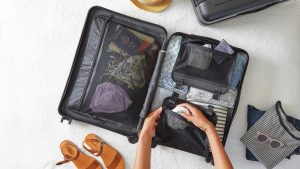
Between finding an affordable flight, navigating an unfamiliar area, and learning a new language, traveling can be just as stressful as it is enjoyable.
As valid as these concerns are, don’t let them get in the way of your leisure time. Here are 12 tips you can use before, during, and after your travels to reduce any additional stress. Plus, a ton of apps that’ll help you do it!
Set a budget.
It’s easy to get carried away with spending when you’re in an exciting new area with tons of fun things to do and tasty dishes to try. However, you don’t want to end up with empty pockets in an unfamiliar place. That’s why setting a budget before you go on a trip is essential to have the most relaxing time possible.
Making a spreadsheet is a great, effective way to track your expenditures. You can easily work out daily costs based on room rates and meal costs. For example, ordering room service in a hotel every day will cost more than if you bought groceries and cooked in a hostel. The app Pearbudget is a great tool that suggests the ways you can cut unnecessary expenses from your trip.
If you’re a self-proclaimed adrenaline junkie and like to partake in extreme activities, travel insurance is a great investment, even if you’re only traveling for a week. This will save you money in the long run if you end up getting sick or hurt on your vacation. You should also consider expenses tied to travel visas and possible vaccinations.
Lastly, remember to be flexible with your budget. Be strict enough with your expenses so you don’t rack up a hefty credit card bill, but lax enough to be able to make a spontaneous decision now and again. Treat yourself!
Consider your options when booking flights.
The price of flights can take up a good chunk of your travel budget. That’s why it’s important to do your research and monitor ticket prices in order to get the best deal.
Hopper is a free smartphone app that takes the hassle out of booking flights. All you have to do is set the departure and arrival airports and length of stay. You can also choose if you want a direct or non-stop flight. Hopper then lists the most affordable options from a variety of airlines.
Hopper also “watches” your flight for you and will let you know if you should book immediately or wait for a lower price. By using this app it will take a few seconds to do what hours of online researching would.
Travel search engines like Kayak and Google Flights are equally helpful in getting the best deals. Prices increase during the final three weeks before departure, so try to book within three months to 30 days in advance.
Organize your itinerary.
Whether you like to have every hour of your trip planned or you are more of a spontaneous, go-with-the-flow-type traveler, it’s helpful to have a general outline of your plans.
First, identify your priorities. Start with the adventures that you are the most excited about. Then, if you have empty slots of time, either fill them with other activities or leave them open for a last-minute thrill.

Is there a change of plans, such as a delayed flight? TripIt also allows you to send a message at the quick touch of a button.
Pack efficiently.
Are you an Overpacker, with enough items stuffed in your suitcase to prepare you for anything life throws at you? Or maybe you never pack enough, and have to run to the closest store to buy some last-minute necessities?

Start your list as soon as you book your trip and add to it over time. You can start by packing items you won’t need until your trip and saving the things you need on a daily basis for last. The most important things to remember are any medications, IDs, or credit cards you might need.
If you haven’t mastered the art of packing, PackPoint helps you pack easily and efficiently based on how long your trip is, the weather, and the activities you’ll participate in. It’ll even take doing laundry into consideration if you plan on making a stop to a local laundromat. PackPoint has a user-friendly interface and is super easy to use, not to mention it won’t cost you anything!
Be prepared at the airport.

If you’re a frequent flyer, getting TSA PreCheck will ease the flying process by letting you skip long lines and cut down on a few common security checks.
Flight times are finicky. Be prepared if your flight gets delayed, and don’t stress out over it; it happens! Make sure to bring your headphones, a laptop, a book, or even something to doodle on to make the time go by faster. Find your gate, and then go grab a meal at a restaurant nearby.
Learn the language beforehand.
Don’t let a language barrier stop you from traveling to some of the coolest places on Earth. It can be nerve-wracking to experience an unfamiliar dialect, but there are a few ways you can make communication a bit easier.

It’s a good idea to keep your address written somewhere handy so it’s easy to find your way back or show the cab driver. Translation apps, although not always perfect, can serve as a communication aid. TripLingo and the Google Translate app are great places to start.
The most important thing is to always be friendly. A smile is universal!
Keep the peace.
You love your family and friends, and can’t wait to spend quality time with them. However, it’s not long before you start getting on each other’s nerves. While you’re more of a wake-up-early-and-do-everything kind of traveler, your travel companions like to sleep in and see where the day takes them. Both are perfectly fine ways to explore, but heads clash when it comes to splitting up your day, and frustrations arise.
It’s important to be flexible and cater to the needs of every party. For every activity or restaurant you choose, they get to choose the next day. Go with the flow and accept that some plans may change, but that’s the spontaneity and excitement that comes with traveling.
Everyone has different lifestyle habits, so be sure not to judge your companions for staying on a strict burger-and-fries diet instead of trying local cuisine, or for sleeping in too late.
And if everything is going along smoothly, it’s still helpful to have some alone time. Whether it’s taking a walk or going to a museum, recharging your social batteries is a necessity. Plus, solo activities make for great conversation at a group dinner!
Research food options.

Know what to expect beforehand by finding out what local dishes to expect along with scanning menus of restaurants in the area. If you’re traveling internationally, you can get an allergy card from your doctor that lists your restrictions in multiple languages.
Although many eateries are happy to help cater to your dietary needs, there’s always HappyCow to help if you feel uncomfortable asking. Using this app, you can find plant-based, healthy food around the world. You’ll never have to sift through tons of menus, trying to customize a dish so it fits your lifestyle.
Find Me Gluten Free is another app that will save you time and trouble finding gluten-free meals while traveling. Have your cake and eat it too!
Know where you’re going.
Whether you’re in an Uber or traveling on foot, you should take safety precautions so you end up where you need to be.

If you plan on traveling off the beaten path, Komoot is a great navigation app. Designed for hikers and bikers, Komoot features turn-by-turn voice navigation to keep you hands-free. What’s even better is that Komoot lets you know what trails have the highest difficulty and elevation.
If you’re more of a city slicker, Here WeGo is another free app that will inform you of the best routes to take by car, bike, or foot. It also gives you real-time updates and transportation prices.
Be prepared for unexpected curveballs.
Oh no! You’re on your dream vacation and you start to feel under the weather. Or you ran out of cash and can’t find an ATM anywhere to pay off your check at a restaurant that only accepts bills.
While no one can predict the future, you can take multiple precautions to make sure you’re ready for the worst.
It’s important to have extra cash in case of an emergency, such as if your ATM card isn’t working or your wallet gets lost or stolen. Keep the stash in a safe place where you’re staying instead of carrying it on you. It’s also helpful to have a backup bank or credit card handy in case one is suspended for suspicious activity.
Make copies of important documents, such as your passport, and keep a list of emergency contacts in your bag and hotel room in case anything happens.
For minor health issues, it doesn’t hurt to bring a small pill box filled with over-the-counter medicine for the occasional headache or stomach pain.
If you’re worried about more serious threats, you can download the app Sitata Travel Safe on your smartphone. It monitors the area for safety hazards, disease outbreaks, violent protests, and any other threats. Using this app, you can also search for nearby hospitals and get contact information for local emergency services.
No one wants to think about worst-case scenarios on what is meant to be a relaxing vacation, but it definitely doesn’t hurt to be prepared!
Back up your photos.

First off, make sure you have enough cloud storage to hold all of your photos. It’s always important to have them saved multiple places in case the files get corrupted, deleted, or hacked. You can also upload your photos onto Google Drive or a private album on a social media platform, such as Facebook.
Make it a routine to upload your photos each day to multiple spots, so you don’t get stuck doing it all at once.
Have something planned to look forward to, or start researching your next trip!
Ever had a case of post-travel depression, or PTD? Even if you just had the trip of a lifetime, a traveler’s wanderlust can never truly be satisfied.
The best way to overcome PTD is to have a trip, or any activity you can look forward to, planned for in the upcoming months. Coming home from a vacation is always bittersweet, but at least you can start planning a new adventure. And by using all these tips, it’ll likely be another stress-free vacation!
